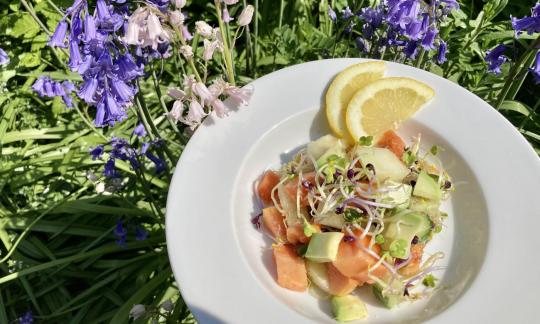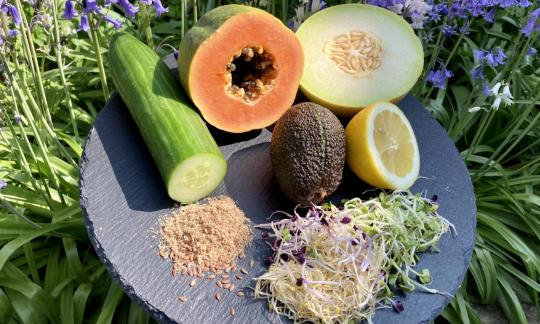Fruity sprout salad with papaya and cantaloupe
raw-vegan
Ingredients (for servings, )
| For the salad base | |
|---|---|
| ½ | Cucumbers, raw (organic?) (8.1 oz) |
| 11 oz | Papaya, raw (organic?) |
| ½ | Galia melons, raw (organic?) (21 oz) |
| 1 | Avocados, raw (organic?) (7.1 oz) |
| 3 ½ oz | Lucerne seeds, germinated, raw (Alfalfa, ~snail clover, organic?) |
| For the dressing | |
| 2 tsp, whole | Linseed, raw, organic? (golden linseed, flax) (0.24 oz) |
| ¼ | Lemons, raw (limes, organic?) (0.51 oz) |
| Optional | |
| 1 dash | Table salt (table salt, raw?, organic?) (0.01 oz) |
| 2 dash | Black pepper (organic?, raw?) (0.01 oz) |
Equipment
- coffee grinder, electric
- citrus juicer (lemon squeezer)
- sieve
Type of preparation
- chop or grind
- squeeze
- drain
Preparation
For the salad
Wash the cucumber and cut it into small cubes, including the peel. Cut the flesh of the papaya and cantaloupe into small cubes. Remove the avocado from the skin and dice. Rinse the alfalfa sprouts, drain and pull them apart a little. Put everything in a bowl.You can use different types of melon: honeydew melon, cantaloupe melon or galia melon. They all taste a little different, but are all suitable for this salad because of their sweetness. We used the galia melon (net melon).
Sprouts: If you don't have alfalfa sprouts on hand, you can replace them with any kind of sprouts, such as cress ( water cress or garden cress), radishes or mung bean sprouts.
For the dressing
Grind the flax seeds in a coffee grinder and mix with the freshly squeezed lemon juice. Optionally season with pepper and salt.Finishing the salad
Pour the dressing over the salad and mix. Serve immediately.
|
Nutritional Information per person
Convert per 100g
|
2000 kcal | |
|---|---|---|
| Energy | 442 kcal | 22.1% |
| Fat/Lipids | 17 g | 24.7% |
| Saturated Fats | 2.6 g | 12.8% |
| Carbohydrates (inc.dietary fiber) | 71 g | 26.3% |
| Sugars | 52 g | 57.6% |
| Fiber | 14 g | 56.6% |
| Protein/Albumin | 8.8 g | 17.6% |
| Cooking Salt (Na:154.0 mg) | 391 mg | 16.3% |
| Essential micronutrients with the highest proportions | per person | 2000 kcal | |
|---|---|---|---|
| Vit | Vitamin C (ascorbic acid) | 212 mg | 264.0% |
| Vit | Vitamin B9, B11 (Folate, as the active form of folic acid) | 257 µg | 128.0% |
| Elem | Potassium, K | 1'934 mg | 97.0% |
| Vit | Vitamin A, as RAE | 675 µg | 84.0% |
| Vit | Vitamin K | 62 µg | 83.0% |
| Fat | Alpha-Linolenic acid; ALA; 18:3 omega-3 | 1.1 g | 56.0% |
| Vit | Vitamin B6 (pyridoxine) | 0.70 mg | 50.0% |
| Vit | Vitamin B1 (Thiamine) | 0.53 mg | 48.0% |
| Vit | Vitamin B5 (Pantothenic acid) | 2.9 mg | 48.0% |
| Min | Copper, Cu | 0.43 mg | 43.0% |
Detailed Nutritional Information per Person for this Recipe
The majority of the nutritional information comes from the USDA (US Department of Agriculture). This means that the information for natural products is often incomplete or only given within broader categories, whereas in most cases products made from these have more complete information displayed.
If we take flaxseed, for example, the important essential amino acid ALA (omega-3) is only included in an overarching category whereas for flaxseed oil ALA is listed specifically. In time, we will be able to change this, but it will require a lot of work. An “i” appears behind ingredients that have been adjusted and an explanation appears when you hover over this symbol.
For Erb Muesli, the original calculations resulted in 48 % of the daily requirement of ALA — but with the correction, we see that the muesli actually covers >100 % of the necessary recommendation for the omega-3 fatty acid ALA. Our goal is to eventually be able to compare the nutritional value of our recipes with those that are used in conventional western lifestyles.
| Essential fatty acids | per person | 2000 kcal |
|---|---|---|
| Alpha-Linolenic acid; ALA; 18:3 omega-3 | 1.1 g | 56.0% |
| Linoleic acid; LA; 18:2 omega-6 | 2.1 g | 21.0% |
| Essential amino acids | per person | 2000 kcal |
|---|---|---|
| Tryptophan (Trp, W) | 0.10 g | 38.0% |
| Threonine (Thr, T, irreversibly transaminated) | 0.32 g | 35.0% |
| Lysine (Lys, K, irreversibly transaminated) | 0.54 g | 29.0% |
| Isoleucine (Ile, I) | 0.34 g | 27.0% |
| Valin (Val, V) | 0.40 g | 25.0% |
| Leucine (Leu, L) | 0.58 g | 24.0% |
| Phenylalanine (Phe, F) | 0.26 g | 17.0% |
| Methionine (Met, M) | 0.10 g | 11.0% |
| Vitamins | per person | 2000 kcal |
|---|---|---|
| Vitamin C (ascorbic acid) | 212 mg | 264.0% |
| Vitamin B9, B11 (Folate, as the active form of folic acid) | 257 µg | 128.0% |
| Vitamin A, as RAE | 675 µg | 84.0% |
| Vitamin K | 62 µg | 83.0% |
| Vitamin B6 (pyridoxine) | 0.70 mg | 50.0% |
| Vitamin B1 (Thiamine) | 0.53 mg | 48.0% |
| Vitamin B5 (Pantothenic acid) | 2.9 mg | 48.0% |
| Vitamin B7 (Biotin, ex vitamin H) | 18 µg | 35.0% |
| Vitamin B3 (Niacin) | 5.1 mg | 32.0% |
| Vitamin E, as a-TEs | 2.9 mg | 24.0% |
| Vitamin B2 (Riboflavin) | 0.28 mg | 20.0% |
| Essential macroelements (macronutrients) | per person | 2000 kcal |
|---|---|---|
| Potassium, K | 1'934 mg | 97.0% |
| Magnesium, Mg | 136 mg | 36.0% |
| Phosphorus, P | 225 mg | 32.0% |
| Sodium, Na | 154 mg | 19.0% |
| Calcium, Ca | 129 mg | 16.0% |
| Essential trace elements (micronutrients) | per person | 2000 kcal |
|---|---|---|
| Copper, Cu | 0.43 mg | 43.0% |
| Manganese, Mn | 0.49 mg | 24.0% |
| Zinc, Zn | 1.9 mg | 19.0% |
| Iron, Fe | 2.6 mg | 18.0% |
| Selenium, Se | 2.8 µg | 5.0% |
| Iod, I (Jod, J) | 6.7 µg | 4.0% |
| Fluorine, F | 8.6 µg | < 0.1% |
The fruity sprout salad with papaya and sugar melon is rich in vitamins such as folic acid and fiber that promotes digestion.
Nutrient profile: One portion covers more than twice the average daily requirement of vitamin C. Potassium and folic acid are 100% covered and vitamins A and K are over 80% covered. The ratio of omega-6 to omega-3 fatty acids is 2:1, well below the maximum recommended ratio of 5:1. More on this under: Vegans often eat unhealthily. Avoidable nutritional errors.
Alfalfa: The (seed) alfalfa, which belongs to the Fabaceae family, is also known under the name alfalfa. The germinated, low-calorie sprouts are among the most popular of their kind thanks to their mild, nutty taste. They are rich in protein (almost 10%) and fiber, but are primarily good for their vitamin K content, which is involved in coagulation, bone metabolism and vascular regeneration, among other things.
Papaya: A papaya consists of over 85 percent water and is therefore extremely low in calories. Papayas are known for their protein-splitting enzymes, especially papain. Papain is said to promote digestion and have a mild laxative effect.
Papayas also have a high vitamin C content. According to the European RDA (Recommended Dietary Allowance), 100 grams covers around ¾ of the vitamin C requirement.
Cantaloupes: Melons belong to the gourd family and are therefore not actually fruits. Basically, a distinction is made between watermelons and sugar melons. The latter are divided into three large groups: honeydew melons, netted melons and cantaloupe melons. The honeydew melon is elongated oval, its skin is yellow and smooth. The sweet flesh is greenish-white. The netted melon, also called Galia melon, is spherical. When unripe, its skin, which is covered with a fine mesh, is green. The skin of the ripe netted melon is yellow, the flesh is greenish-white. The cantaloupe melon is the sweetest and one of the finest sugar melons. The greenish-beige skin has a net-like structure. The sweet flesh is soft and bright orange.
Avocado: The avocado has by far the highest fat content of all known fruits and vegetables. The fat is mostly unsaturated fatty acids. The high proportion of indigestible fiber lowers cholesterol levels. Avocados also contain many valuable vitamins and minerals.
Flaxseed: Flaxseed has a slightly nutty taste and a 40% fat content. With around 50% of the polyunsaturated omega-3 fatty acid alpha-linolenic acid (ALA), it has the highest concentration of omega-3 fatty acids of all known vegetable oils. Flaxseed has an extremely healthy fatty acid ratio of 1:4 (omega-6 to omega-3).
Preventing avocados from turning brown: Cutting an avocado causes a break in the affected cell walls, which exposes the substances that escape to the oxidation process. This in turn causes the flesh to turn brown if you do not use it immediately. If you still want to prepare the avocado beforehand, sprinkling it with lemon or lime juice can prevent it from turning brown and also goes well with the salad.
Storage of avocados: Avocados are harvested when they are unripe. To ripen them, it is best to place avocados next to apples (or put them together in a paper bag) and store them at room temperature. The apple emits the gas ethylene, which promotes ripening.
Oil: We have deliberately avoided oil for health reasons and instead used linseed as a healthy source of fatty acids. You can find more information on this topic in our book, which we describe in detail: "Salt Sugar Fat" by Michael Moss.
Sprouts: If you don't have alfalfa sprouts on hand, you can replace them with any kind of sprouts, such as cress ( water cress or garden cress), radishes or mung bean sprouts.
Sugar melon: Depending on your taste or availability, you can use honeydew melon, netted melon or cantaloupe melon. The sweetness will vary depending on the type used and the ripeness of the fruit.






